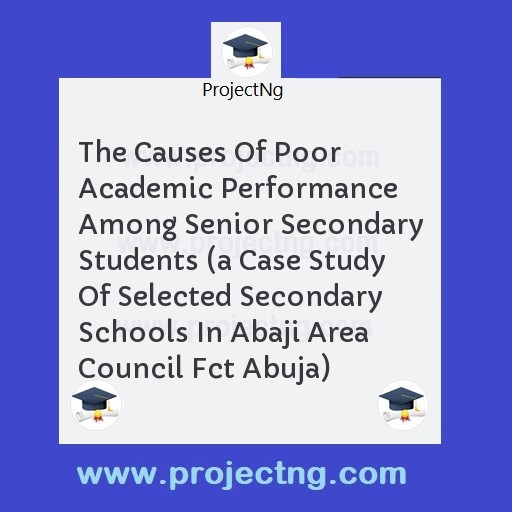The Causes Of Poor Academic Performance Among Senior Secondary Students (a Case Study Of Selected Secondary Schools In Abaji Area Council Fct Abuja)
Education Project Topics
Get the Complete Project Materials Now! »
CHAPTER ONE
INTRODUCTION
1.1 BACKGROUND OF THE STUDY
The causes of poor academic performance among pupils in primary school examinations have currently generated a lot of discussions among many people in the country especially among stakeholders. This abysmally poor performance of students is widespread just as it is disturbing. Recently, a summit of stakeholders under the aegis of National Education stakeholder’s forum was held to address the trend. The convention x-rayed the performance of pupils in the primary schools which is next in the ladder of learning to higher studies. It was generally agreed after prolonged analysis of the situation that the level of performance of primary school pupils is presently on low ebb.
It was also fittingly agreed that most pupils of primary school perform poorly in their final examinations which is a requisite for gaining admission for studies in higher institutions.
Reasons have been advanced for this continual down ward trend in academic performance. These include poor and inadequate teaching, lack of proper motivation of teachers, inappropriate and inadequate instructional materials. Others include dwindling interest in education among pupils and corruption in the system.
1.2 STATEMENT OF THE PROBLEM
A perplexing concern for education stakeholders in the present dispensation in Nigeria is the quality of school leavers. As it were, there are cases of primary school leavers who have been found not able to write clearly and express themselves meaningfully and intelligibly. Of most concern to stakeholders too is the poor performance of pupils in the Common EntranceExaminations,many primary school leavers cannot gain admission to institutions of higher learning owing to poor results. They even could not fit in appropriately as they become overwhelmed by the elaborate and intense workload.
The result of this trend of poor performance is quite diverse. Beside inability to gain entry into institutions of higher learning, there is the danger to a society with young people who are ill-educated; unfit and unqualified. The consequences of this are quite dire for a society or nation that is evolving.
1.3 PURPOSE OF THE STUDY
This study structurally examines the poor performance of pupils in primary schools with particular reference to the common entrance examination. The objectives or purpose of the study shall be:
- To find out the causes of this poor performance.
- To examine the role of pupils in this matter.
- To determine the rate of failure among the pupils.
- To determine the role of other stakeholders which include government, teachers, and the parents.
1.4 SCOPE OF THE STUDY
The study is practically limited to students of some selected primary schools in Abaji Area Council of the Federal Capital Territory. The schools so selected are:
- LEA Model Primary School, Abaji.
- LEA Primary School, Yaba.
- Science Primary School, Nuku.
These schools are quite apart: geographically and socially. The three schools were chosen to facilitate reliable outcomes. The results or findings will however be generalized.
1.5 ASSUMPTIONS
The following assumptions are made to aid in drawing conclusions for the study.
- The syllabus in use for the primary school pupils is inappropriate.
- Supervision of schools by inspectors from the Education Department is not effectively done.
- There is inadequate qualified staff in schools.
- Poor teaching methods contributes to poor performance.
1.6 SIGNIFICANCE OF THE STUDY
There are many factors responsible for the downward trend in the performance of primary school pupils. As this study examines the poor performance of pupils, the study will be significant to several stakeholders.
Curriculum planners will find this study important as they will reconsider the existing curriculum to see if there is need for restructuring it. Some have complained of the existing curriculum as not meeting the expectation of the present realities.
Teachers will find the study valuable with regards to methodologies they use or reviewing same. The study will also be significant to government who is the major stakeholder. The falling standard is quite worrisome. Government will have to review the educational policy which include tests and measurement of students’ performance.
1.7 DEFINITION OF TERMS
The following terms are defined as used in this work.
- Performance: The outcome of a student’s effort.
- Stakeholders: In the education sector, Stakeholders are those who are involved in the planning and execution of educational programmes. Government, teachers, parents, students.
- Reliable: Something that is dependable. It can be trusted.
- X-rayed: Focus; to give attention to something.
- Academic: A teacher or scholar in a college or institute of higher education.
- School: A school is an institution designed for the teaching of students (or "pupils") under the direction of teachers.
- Poor: Worse than is usual, expected, or desirable; of a low or inferior standard or quality.
- Cause: A person or thing that gives rise to an action, phenomenon, or condition.
Be the First to Share On Social

Enjoying our content?
Don't miss out on new videos! Subscribe to our YouTube channel for more awesome content.
Subscribe Now!













